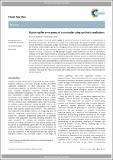Exploring the emergence of complexity using synthetic replicators
Abstract
A significant number of synthetic systems capable of replicating themselves or entities that are complementary to themselves have appeared in the last 30 years. Building on an understanding of the operation of synthetic replicators in isolation, this field has progressed to examples where catalytic relationships between replicators within the same network and the extant reaction conditions play a role in driving phenomena at the level of the whole system. Systems chemistry has played a pivotal role in the attempts to understand the origin of biological complexity by exploiting the power of synthetic chemistry, in conjunction with the molecular recognition toolkit pioneered by the field of supramolecular chemistry, thereby permitting the bottom-up engineering of increasingly complex reaction networks from simple building blocks. This review describes the advances facilitated by the systems chemistry approach in relating the expression of complex and emergent behaviour in networks of replicators with the connectivity and catalytic relationships inherent within them. These systems, examined within well-stirred batch reactors, represent conceptual and practical frameworks that can then be translated to conditions that permit replicating systems to overcome the fundamental limits imposed on selection processes in networks operating under closed conditions. This shift away from traditional spatially homogeneous reactors towards dynamic and non-equilibrium conditions, such as those provided by reaction-diffusion reaction formats, constitutes a key change that mimics environments within cellular systems, which possess obvious compartmentalisation and inhomogeneity.
Citation
Kosikova , T & Philp , D 2017 , ' Exploring the emergence of complexity using synthetic replicators ' , Chemical Society Reviews , vol. 46 , no. 23 , pp. 7274-7305 . https://doi.org/10.1039/C7CS00123A
Publication
Chemical Society Reviews
Status
Peer reviewed
ISSN
0306-0012Type
Journal article
Description
This work was supported by University of St Andrews and the award of a Postgraduate Studentship from Engineering and Physical Sciences Research Council (EP/K503162/1) to T. K.Collections
Items in the St Andrews Research Repository are protected by copyright, with all rights reserved, unless otherwise indicated.

